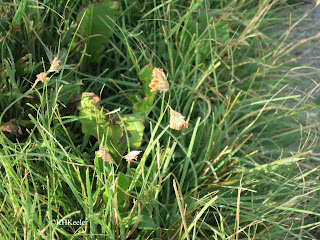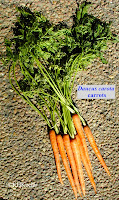 |
| Buchloë dactyloides or Bouteloua dactyloides ??? |
Botanists routinely assert that each plant has only one scientific name. When you look up a plant and find two authoritative sources giving different scientific names, botanists seem like liars.
I recently encountered that with buffalo grass, listed as both Buchloë dactyloides and Bouteloua dactyloides. (posts on buffalo grass: and bison, drought-tolerance)
 |
| Theobroma cacao |
Sometimes the explanation of the two names is that one is older and has been replaced. Since publications continue to be useful for decades or centuries, botanical authorities could have changed the plant name in the time since the article was written. Usually you can spot that by comparing the publication dates of the sources of the two different names. Reprinted books and inaccurate information on the internet can confuse the issue, however.
Nevertheless--
There remain a few cases of one plant with two scientific names even when you compare dates and use sources written since, say, 2010. One of those is buffalo grass, whose scientific name is Buchloë dactyloides or Bouteloua dactyloides, depending on your source.
In this case, botanical authorities have not come to a consensus.
This is pretty geeky, feel free to skip
Here's what happened. Buffalo grass was first described for science in 1818 by Thomas Nuttall as Sesleria dactyloides. In 1869 Georg Englemann published a revision of buffalo grass and its relatives. Englemann kept the name Sesleria for other plants and set buffalo grass apart from them as Buchloë dactyloides. That change was accepted by the botanical community so Buchloë dactyloides was the only valid name for buffalo grass for 130 years.
 |
| hairy grama, Bouteloua hirsuta |
 |
| side-oats grama, Bouteloua curtipendula |
 |
| blue grama, Bouteloua gracilis |
Columbus could have split Bouteloua into several genera, each monophyletic but very small, but chose not to. That was in1999. The scientific name on the USDA Plants website shows that change. On USDA Plants, buffalo grass is Bouteloua dactyloides.
| Changes in genera (and families and orders) are judgement calls about how different things in the same group should be. Another set of judgement calls are made about whether big quite variable groups annoy you more than many tiny but uniform groups. (That is the difference between what are classically termed lumpers vs splitters. Lumpers make big groups while splitters prefer lots of little groups). |
In 2001 Hilu and Alice published a DNA analysis of the relationships of the subfamily of the grasses that included Bouteloua and Buchloë. In their paper they generally agree with the results of the Columbus paper, BUT they retained the names of the small genera Columbus put into Bouteloua, and in particular keep Buchloë as separate from Bouteloua.
The Flora of North America's Volume 25, which covered the grasses Bouteloua and Buchloë and their North American relatives, was published in 2003. Three different experts wrote sections on grass genera that Columbus merged into Bouteloua. They each mention Columbus's 1999 paper but chose to keep the genera separate "pending corroboration from other studies." In the Flora of North America, it is Buchloë dactyloides.
In 2004 Budak and colleagues studied DNA variation in buffalo grass. They wrote "based on three organelle sequences, Buchloë should not be included in the genus Bouteloua as suggested by Columbus…" They thought the DNA-level differences between plants traditionally called Bouteloua and buffalo grass were too different to be in the same genus.
In short, some specialists, publishing in the last 15 years, would merge buffalo grass into the genus Bouteloua, while others would keep it separate.
There are a series of judgement calls involved here. The author who proposed the merger preferred one genus Bouteloua with 56 species over 9 genera, 5 with only 1 species. Other grass experts seemed to agree about the relationships, but not that lumping all of them into the genus Bouteloua was the answer. They kept the older genus names. To complicate things, a third group concluded that buffalo grass was so different it shouldn't be called Bouteloua.
So......
Right now some experts call buffalo grass Bouteloua and others call it Buchloë. It could remain a mess for years because the name choice reflects philosophical differences in how to classify plants.
Right now some experts call buffalo grass Bouteloua and others call it Buchloë. It could remain a mess for years because the name choice reflects philosophical differences in how to classify plants.
What does someone who just wants the plant's scientific name do? In this case, right now, you can use the name you like best. Perhaps the one you can spell. Or you could use the same name as a particular authority. Use the name the USDA Plants website chose (Bouteloua), or the name in the Flora of North America (Buchloë ).
There aren't a lot of cases where the plant is common and the experts disagree, but those cases make nonexperts wonder about the system. All I can tell you--and I too am a user of scientific names, not a maker of scientific names--is that the goal is a single scientific name for each plant, but that sometimes the specialists take a while to come to an agreement on what that name should be.
 |
| buffalo grass |
Corrections and comments welcome.
Free Offer: I combined my blogs about plant names and the rules governing them into an ebook Botany Rules 1-6 of this blog), entitled Botany Rules.
It's free.
To receive your copy click here: Botany Rules ebook
References
Barkworth, M. E. 2003. 17.47. Opizia J. Presl. pp. 269-270 In Flora of North America north of Mexico, Vol. 25 Magnoliophyta: Commelinidae (in part): Poaceae, part 2. Floral of North America Editorial Committee, editors. New York, Oxford University Press.
Budak, H. R. C. Shearman and I Dweikat. 2005. Evolution of Buchloë dactyloides based on cloning and sequencing of matK, rbcL, and cob genes from plastic and mitochondrial genomes. Genome. 48: 411-416.
Columbus, J. T. 1999. An expanded circumscription of Bouteloua (Gramineae: Chloridoideae): New combinations and names. Aliso 18: 61–65.
Columbus, J. T. M. S. Kinney, R. Pant and M.E Siqueirros, D.1998. Cladistic parsimony analysis of internal transcribed space region (nrDNA) sequences of Bouteloua and relatives (Gramineae: Chloridoideae): Aliso 17: 99-130.
Hilu, K. W. and L. A. Alice. 2001. A phylogeny of the Chloridoideae (Poaceae) based on matK sequences. Systematic Botany. 26(2): 386-405.
Snow, N. 2003. 17.48 Buchloë Engleman. pp. 270-271 In Flora of North America north of Mexico, Vol. 25 Magnoliophyta: Commelinidae (in part): Poaceae, part 2. Floral of North America Editorial Committee, editors. New York, Oxford University Press.
Wipft, J. K. 2003. 17.46. Bouteloua Lag. pp. 250-269 In Flora of North America north of Mexico, Vol. 25 Magnoliophyta: Commelinidae (in part): Poaceae, part 2. Floral of North America Editorial Committee, editors. New York, Oxford University Press.
More at awanderingbotanist.com
Join me on Facebook https://www.facebook.com/AWanderingBotanist


FYI
ReplyDelete"To receive your copy click here: Botany Rules ebook"
this link is no longer viable